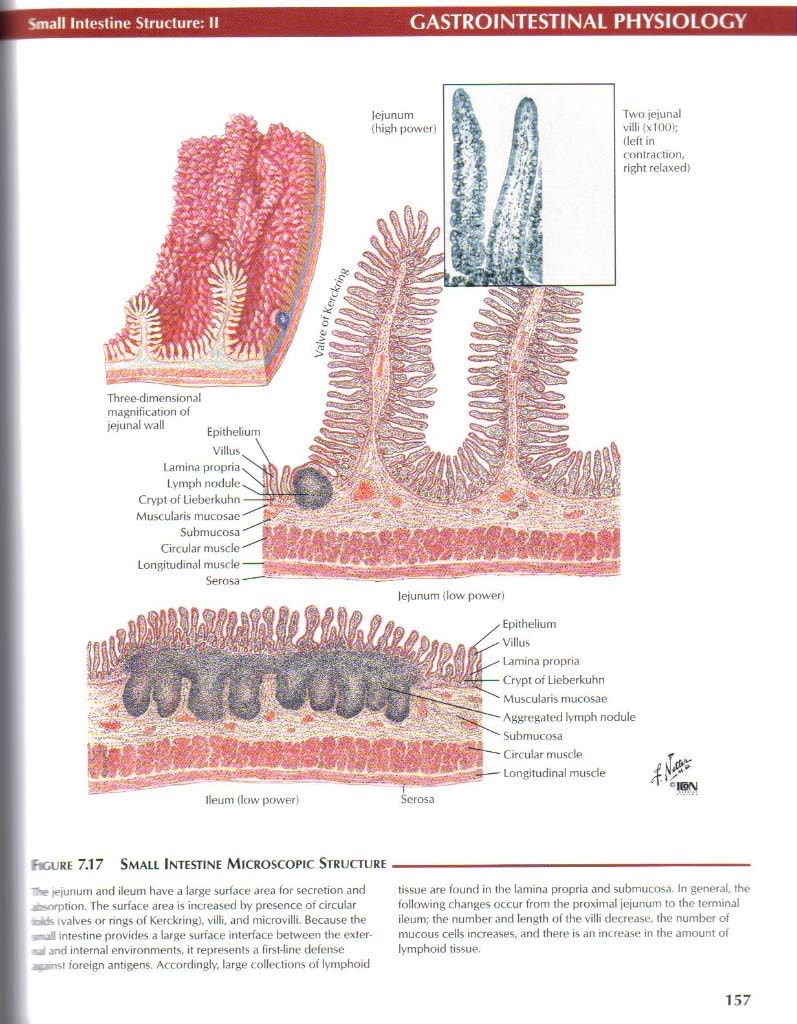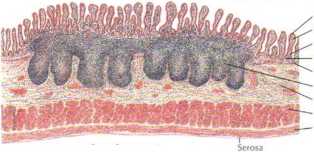30238 netter139

Smali Inlestine Structure: II
GASTROINTESTINAL PHYSIOLOGY
Icjunum (high power)
Two jejunal villi <x100>; (left in contraction, right relaxed>
Three-dimensional magnification of jejunal wali
Lamina Lymph Crypt of Lieberkuhn Muscularis
Submucosa Circular muscle Longitudinal muscle Serosa
lejunum (Iow power)

lleum (Iow power)
Epithelium
Villus

Lamina propria Crypt of Licberkuhn Muscularis mucosae Aggregaled lymph nodule Submucosa Circular muscle Longitudinal muscle
Figurę 7.17 Small Intestine Microscopic Structure
“■*« lejunum and ileum have a large surface area for secretion and jrsorption. The surface area is inueased by presence of circular -•o-? valves or nngs of Kerckring), villi, and microvilli. Because the ■s—«a£l intestine provides a large surface interface between the exter-j and internal environments, it represents a first-łine defense _jmst forcign antigens. Accordmgly, large collections of lymphoid tissue are found in the lamina propria and submucosa. In generał, the following changes occur from the proximal jejunum to the terminal ileum; the number and lenglh of the villi decrease, the number of mucous cells increases, and there is an inc/ease in the amount of lymphoid tissue.
157
Wyszukiwarka
Podobne podstrony:
netter138 Smali Intestine Slructure: IGASTROINTESTINAL PHYSIOLOGY Figurę 7.16 Small Intfstine Struct
netter140 GASTROINTESTINAL PHYSIOLOGY Smali Intestinc Structure: III Mitochondria Tight junctions ■
netter136 Gaslric Secretion: IIGASTROINTESTINAL PHYSIOLOGY Secrelions of gastric acid (H* ) by parie
netter141 Smali Intestine MotiiityGASTROINTESTINAL PHYSIOLOGY Rhythmic sepmentation Intraluminal
netter49 I I Cardiac Mustlt*: StructureMUSCLE PHYSIOLOGYFlCURF 3.7 SCHEMA OF STRUCFURt OF CARDIAC MU
netter78 Airway Structure: EpithcliumRESPIRATORY PHYSIOLOGY Mucus- Goblet (mucous)
netter49 I I Cardiac Mustlt*: StructureMUSCLE PHYSIOLOGYFlCURF 3.7 SCHEMA OF STRUCFURt OF CARDIAC MU
41783 netter168 Thyroid Gland: StructureENDOCRINE PHYSIOLOGY Hyoid bonę Lymph node Phrenic nerve Sup
więcej podobnych podstron